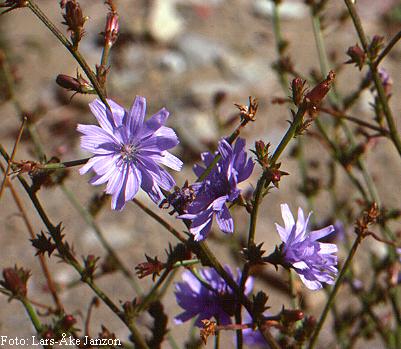Cichorium glandulosum: Red Data Book of Armenia

VU* B 1 ab(ii,iii) + 2 ab(ii,iii)
Category. Vulnerable species. At present three populations are known. The extent of occurrence is less than 5000 km2, the area of occupancy is less than 500 km2. Since the main area of distribution of the species is situated beyond the borders of Armenia, the category of threat has downgraded to VU. The species faces decline of the extent of occurrence and the area of occupancy caused by changes in habitat. It was not included in the first edition of the Red Data Book of Armenia. It is not included in the Annexes of CITES and that of the Bern Convention.
Description. Annual plants. Stems 20–60 cm, whitish, glandulose, usually very branched; branches thickened on tips. Capitula many– flowered. Flowers light blue or whitish.
Distribution. In Armenia it occurs in Yerevan (surroundings of Yerevan, Urts mountain range) and Darelegis (village Rind) floristic regions. EOO is 940 km2, AOO is 30 km2. The number of locations is 4. Besides Armenia grows in Nakhichevan, Anatolia, Syria.
Ecological, biological and phytocoenological peculiarities. Grows in lower and middle mountain belts, at the altitudes of 900–1400 meters above sea level, in the steppes, on red clays of the Tertiary period, on screes. Flowering from May to June, fruiting in July.
Limiting factors. Restricted extent of occurrence and area of occupancy, loss/degradation of habitats caused by land development for arable purposes and grazing.
Conservation actions. Part of the population grows in "Erebuni" State Reserve. Necessary: monitoring of the population state.
Suggestions
 The Ministry of Environment sent a letter international partners to draw their attention to the real danger of environmental disasters as a result of Azerbaijan's large-scale aggression towards the territory of Armenia
The Ministry of Environment sent a letter international partners to draw their attention to the real danger of environmental disasters as a result of Azerbaijan's large-scale aggression towards the territory of Armenia
 Vicia pisiformis: Red Data Book of Armenia
Vicia pisiformis: Red Data Book of Armenia
 Vavilovia formosa: Red Data Book of Armenia
Vavilovia formosa: Red Data Book of Armenia
 Trigonella capitata: Red Data Book of Armenia
Trigonella capitata: Red Data Book of Armenia
 Trigonella astroides: Red Data Book of Armenia
Trigonella astroides: Red Data Book of Armenia












